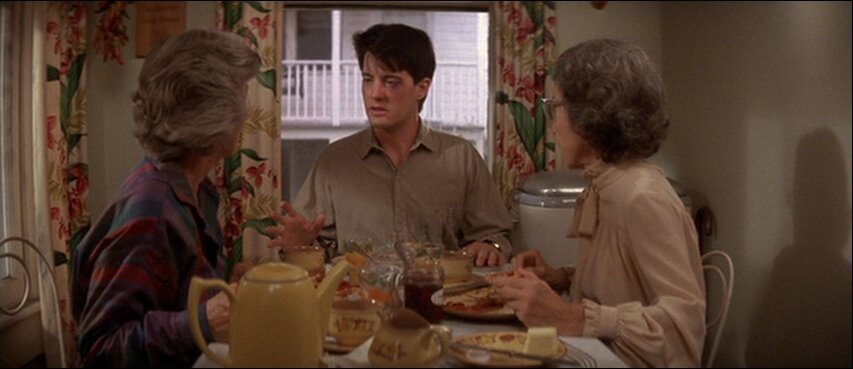Blue Velvet (dir. David Lynch, 1986) - Review
Download the Blue Velvet screenplay for personal, private use.
With its unflinching vision of the violence and insanity simmering beneath the white-picket idyll of American suburbia, Blue Velvet proved keenly prescient of the rhetoric of the ‘two Americas’ which dominated headlines last week.
David Lynch’s controversial 1986 feature recalls various genres and past representations of America, assembling them in conflict and contravention of each other. Lynch forces once-discrete signifiers and sense of American identity into uncomfortable, destabilising proximity, not only through conflicting sensory messages but intermingling genres.
Marshall McLuhan said that “a person engaged in exposition has nothing new to say, and he cannot communicate the effect of participating in the process of discovery. The TV age demands participation in this process.” In Blue Velvet, not only wide-eyed protagonist Jeffrey Beaumont but the viewer are compelled to pick their way through a multiplicity of images and sounds in a futile search for meaning.
Lynch has described the film as “the Hardy Boys go to hell”, a nod to the teenage detective series which clearly influenced the main narrative, the quest of naive college student Jeffrey (Kyle Maclachlan) to solve the mystery of the severed ear. Jeffrey’s much-remarked youthful innocence is perfectly congruent with the visual and auditory language of idyllic fifties suburbia: the family wood shop, the all-American high school, the diner where he discusses his latest clues over milkshakes with his virginal blonde sidekick, Sandy (Laura Dern).
The slick, picture-perfect vision of the American Way is immediately destabilised by an apocalyptic vision, set in motion by the collapse of the illusion of order. The suburban utopia begins to fragment when Jeffrey's father is felled by a stroke, and Jeffrey finds a decomposing ear in the field. With these incidents, Lynch propels the viewer into the menacing, nightmarish underworld of Lumberton which coexists with the world of the white picket fence. By incarnating the American cultural identity in symbols that are as one-dimensional as Hollywood movie sets, Lynch weaves a thread of ambiguity through the web of American self-understanding.
The familiarity of Jeffrey’s character, and the apparent resilience of the narrative frameworks through which the viewer is invited to interpret him, are all the more forcefully shaken by his plunging first into the film noir - with its alienated dark palette and femme fatale Dorothy (Isabella Rossolini) - and then into the uncharted realms of sexual bizarreness and genre collapse. The threat of familiar film villains, like drug dealer Frank (Dennis Hopper), is augmented by the powerful sense of the uncanny, as Lynch throws recognisable elements of one narrative style into another jarringly dissonant one. In the most dramatic and literal instance of the technique, Dorothy intrudes naked upon the wholesome family-sitcom tableau of Sandy’s household, usurping the latter’s place in Jeffrey’s arms.
Jeffrey uncovers mysteries that share a surface similarity with the teen detective stories - set in wholesome small town neighbourhoods- but Lynch exposes a more twisted and unknown America in villains who are unknowable, irrational, and at times violently psychotic. Frank, the utterly excessive antagonist with a penchant for nitrous oxide, sadistic sexual rituals, and sixties ballads incarnates the ultimate mystery of a film which cannot be solved by Jeffrey’s childish sleuthing, or the viewer’s application of such conventional narrative frameworks.
Lynch blatantly mocks the foolish innocence of rosy visions of American suburbia through the character of Sandy, the virginal high schooler who truly believes in the only "happy" vision Blue Velvet offers. When Jeffrey wonders "why are there people like Frank?”, Sandy responds with a pastiche of white America’s sappy, ritualistic inclinations: for every evil in the world, she says, there is its heavenly opposite which will triumph. They are parked in front of a church whose stained-glass windows glow behind the halo of Sandy's blonde hair, and whose organ supplies a feverish soundtrack to her monologue.
Blue Velvet's musical score illustrates the duality inherent in the film. Seemingly innocuous pop songs, such as the 1963 title song by Bobby Vinton, come to be associated with obsessional drives. In Frank's case, they become the stimulus for psychotic episodes of extreme violence, a fusing of his warped emotional state and his need for physical release. By allowing Frank to take the lyrics literally, Lynch draws attention to the subversive and deceptive quality of mass media.
Lynch's ending, with the execution of the criminals, the recovery of Jeffrey’s father, the blessing of Sandy and Jeffrey’s union, the appearance of the robin with an insect in its mouth, and finally the reunion of Dorothy with her kidnapped child, seems to achieve total closure. But it is transparently ironic, a ridiculously happy ending to the small town life of a nuclear family. The symbolic order of the "normal" world has been exposed as a sham and can never be fully restored.
In mimicking styles from earlier eras, Lynch highlights the endlessly reproductive, nostalgic quality of American identity: icons from the 1940s and music from the 1960s coexist with contemporary cars, telephones, machinery, and hospital equipment. The cacophony of cultural icons suggests a disruption of the order inherent in earlier American societies, from the Manifest Destiny of the country’s expansion to the Christianity of the postwar period; in Blue Velvet, the illusion of a reliable order that had sustained earlier generations has collapsed. The replay of the past appears to be the only hope for a culture where the illusion of "living happily ever after" cannot quite cover the ambiguity of experience.
Áine Kennedy is a London-based writer and manager of the ScriptUp blog.






